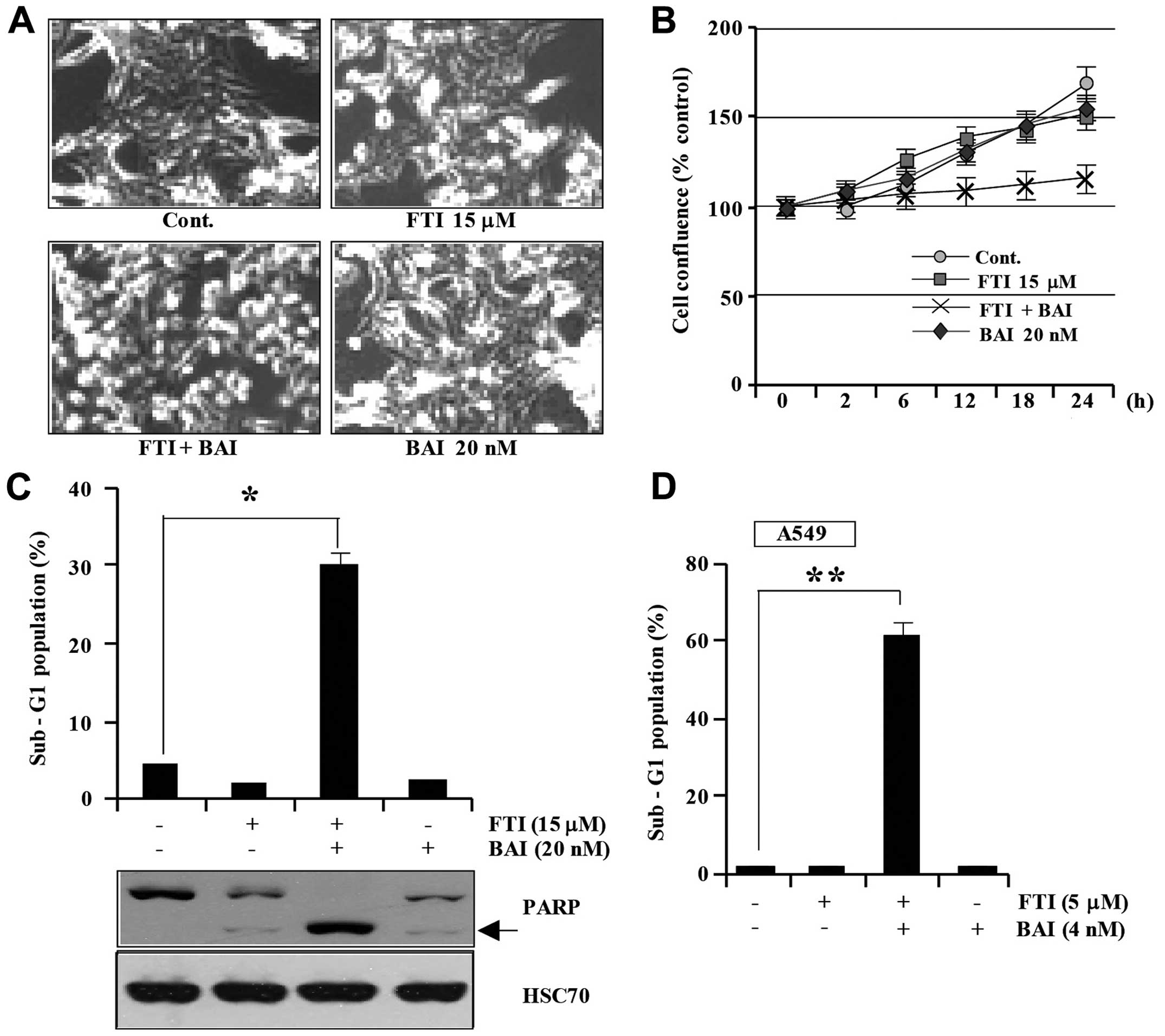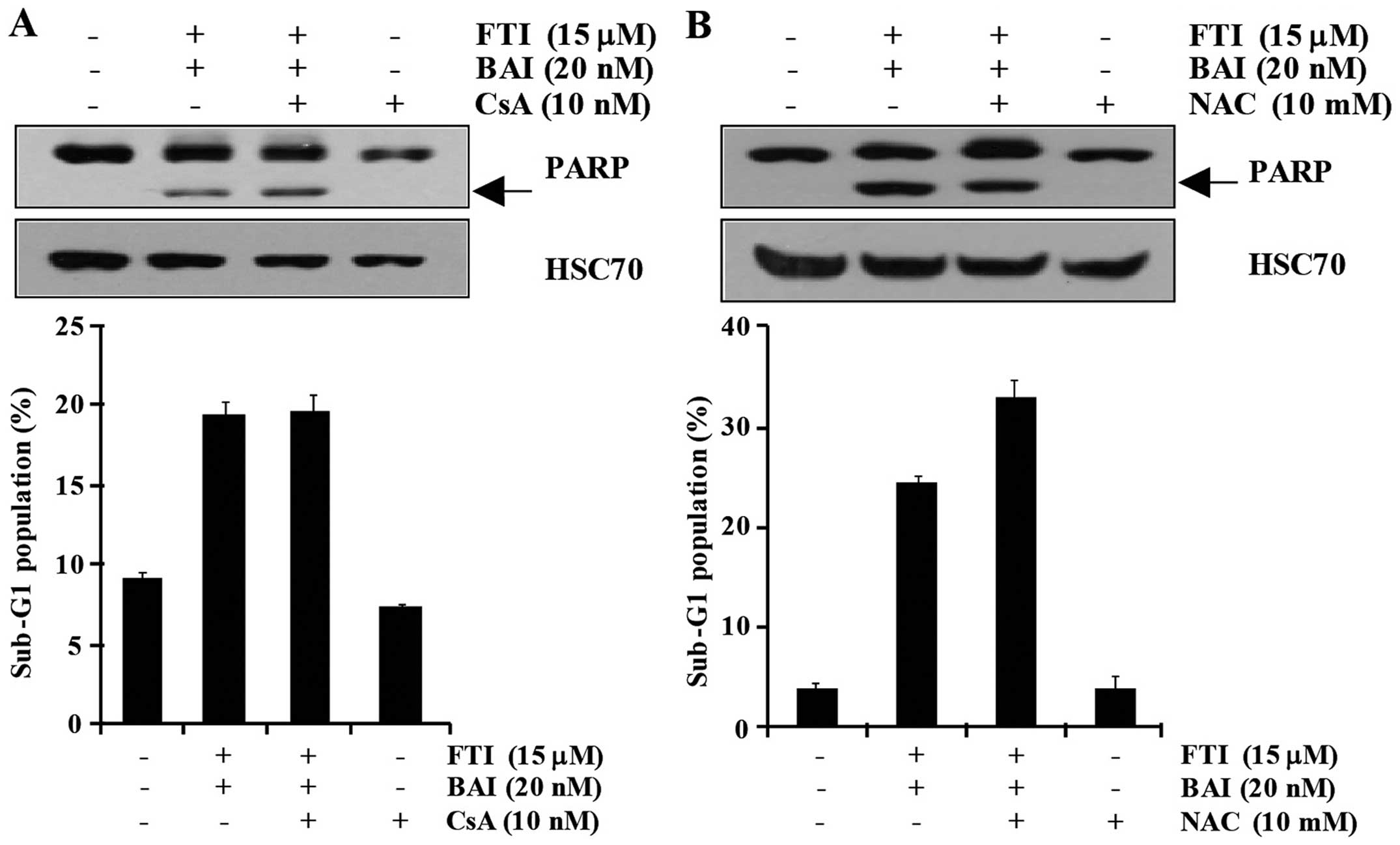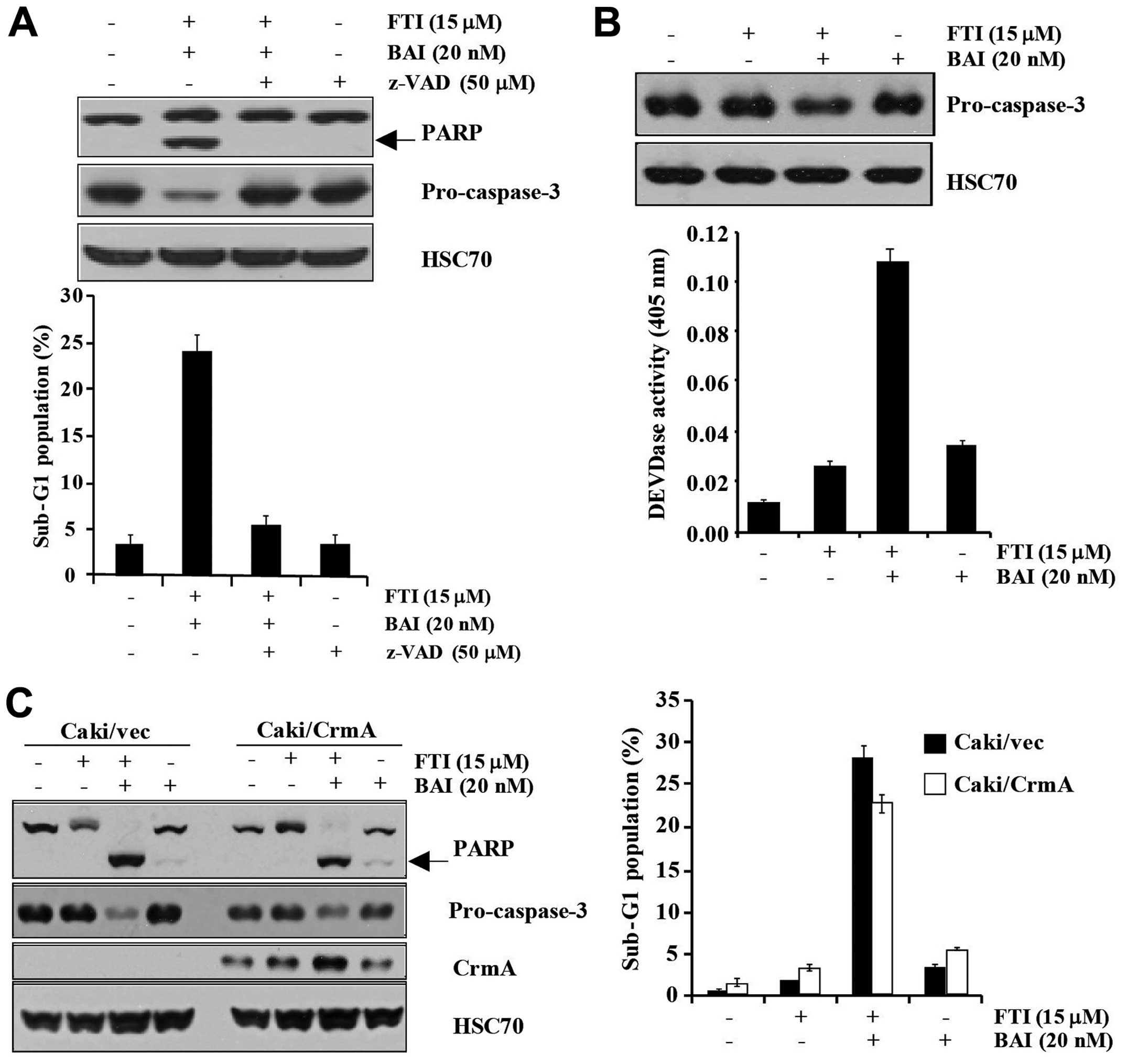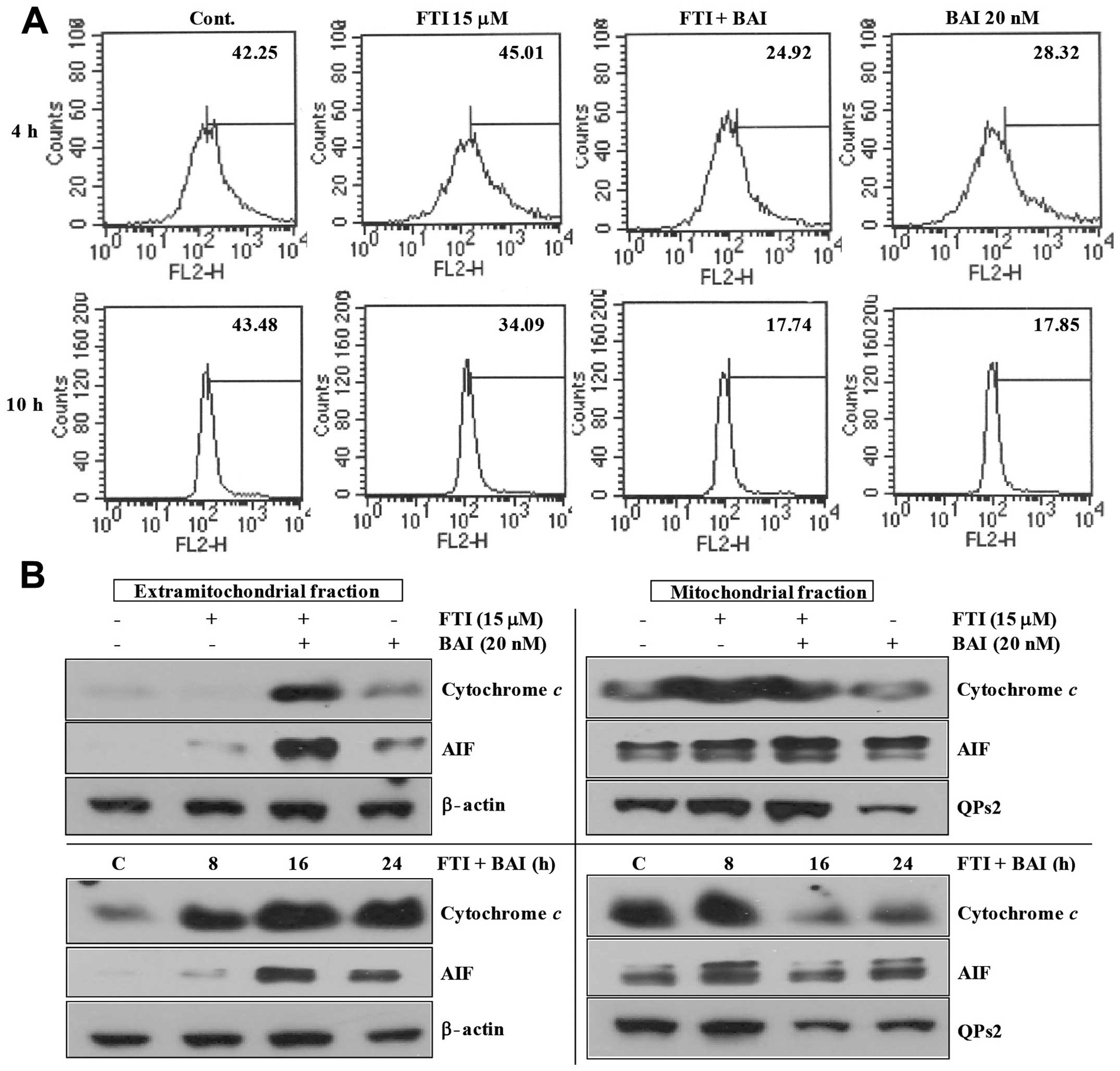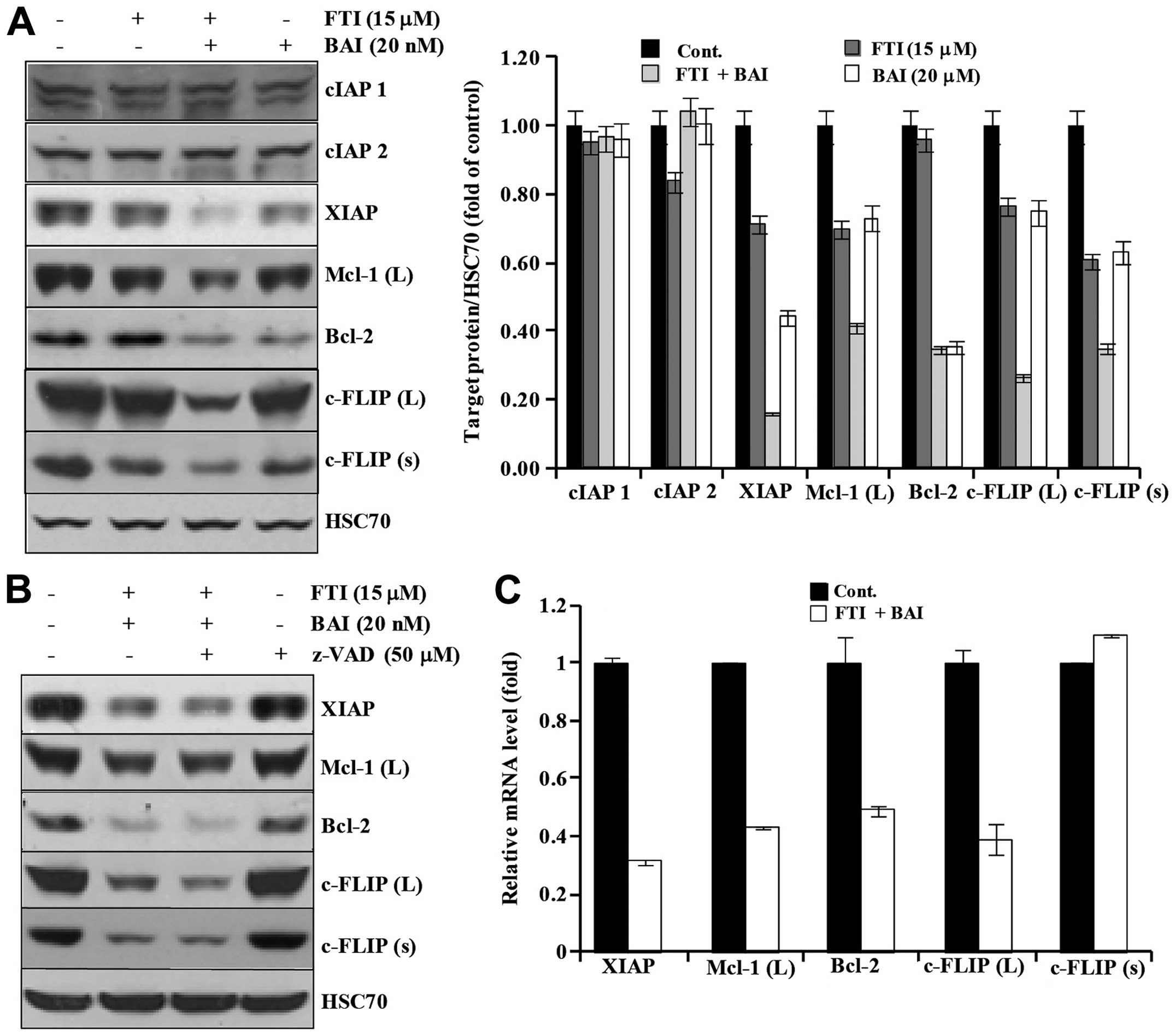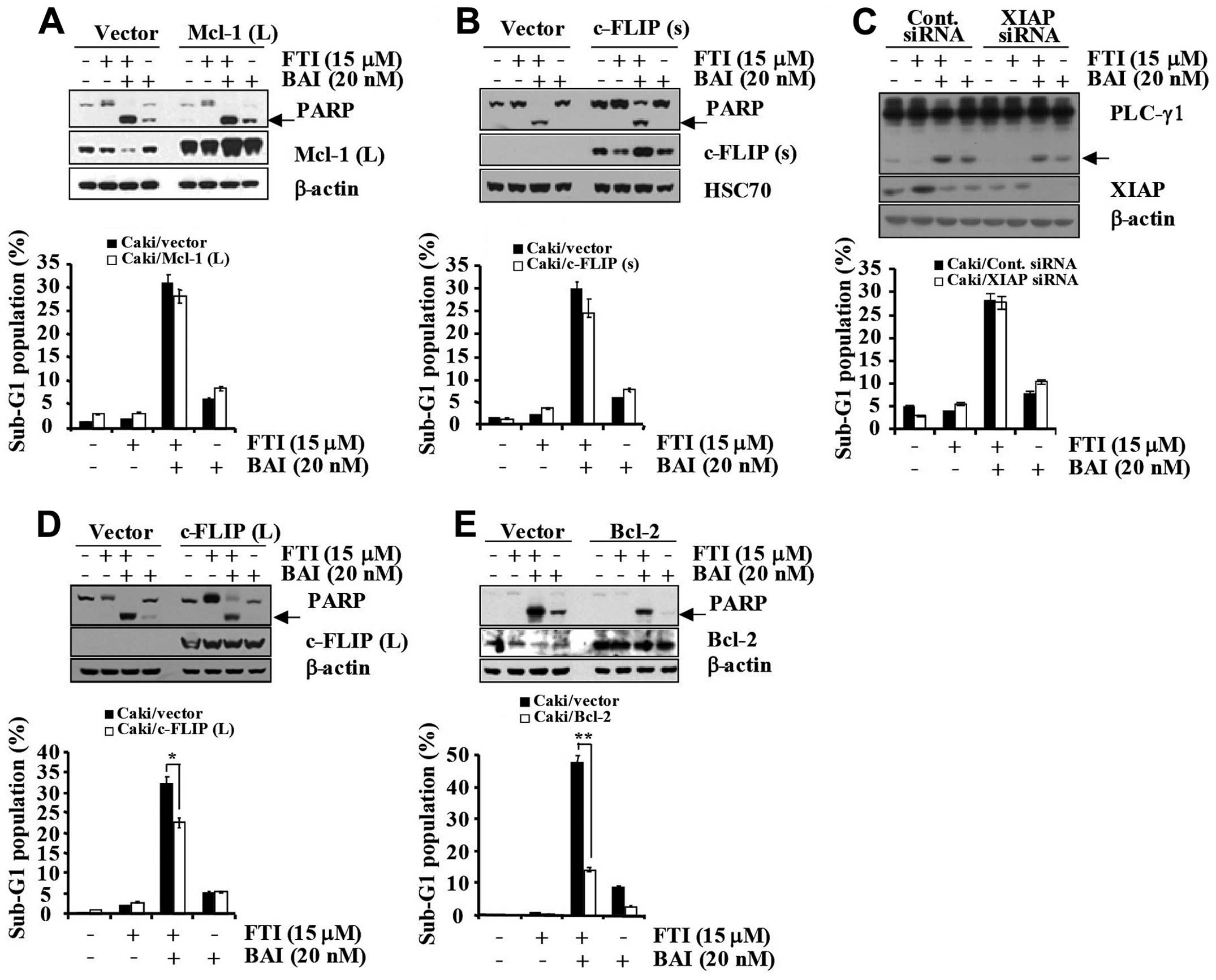BAI, a novel Cdk inhibitor, enhances farnesyltransferase inhibitor LB42708-mediated apoptosis in renal carcinoma cells through the downregulation of Bcl-2 and c-FLIP (L)
- Authors:
- Published online on: July 4, 2014 https://doi.org/10.3892/ijo.2014.2534
- Pages: 1680-1690
Abstract
Introduction
Deregulation of cell cycle progression is a universal characteristic of cancer, and the majority of human cancers have abnormalities in one or more components associated with CDK activity (1). Therefore, synthetic inhibitors of CDK activity present as an appropriate strategy in the development of new cancer therapeutic methods. Based on this hypothesis, we synthesized 2-[1,1′-biphenyl]-4-yl-N-[5-(1,1-dioxo-1λ6-isothiazolidin-2-yl)-1H-indazol-3-yl]acetamide (BAI), one of the 3,5-diaminoindazole derivatives, as a novel CDK inhibitor (2). Our previous studies (3,4) showed that BAI potentially inhibited proliferation at nanomolar concentrations in AMC-HN4, AMC-HN6, A549, Caki, and HCT116 cells.
Ras proteins regulate diverse cellular pathways that are important in the growth and spread of malignancies, including cell proliferation, cell cycle regulation, cell survival, angiogenesis, cell migration (5). It has been reported that carcinogenesis is correlated with activation of Ras in various human cancers (6,7). Because farnesylation of Ras plays an important role in the conversion of Ras to its biologically active form, the inhibition of farnesyltransferase has been studied as a specific molecular targeting therapy for the treatment of various cancers (8–10). Recent studies revealed that several classes of farnesyltransferase inhibitors (FTIs) have anti-proliferative effect on human cancers (11–14). Furthermore, the anticancer effect of FTI can be enhanced by co-treatment with various chemotherapeutic drugs resulting in a synergistic apoptotic response in various tumor cells (15–18). Especially, it has been revealed that the synergistic effect of a cdk inhibitor enhanced FTI-induced apoptosis (18). Novel strategies in developing FTIs have led to a new component in which LB42708, pyrrole-based orally active FTI, has a potent apoptotic effect (14,19).
In the present study, we aimed to elucidate the phenomenon by which the combinational therapy with BAI and LB42708 inhibited growth of human cancer cells, as well as to uncover the molecular biological basis of mechanism for their apoptosis induction in cancer cells.
Materials and methods
Cell lines and culture
The human non-small cell lung cancer (HNSCLC) A549 was obtained from the American Type Culture Collection (ATCC, Rockville, MD, USA) and grown in RPM-1640 medium supplemented with 10% heated-inactivated fetal bovine serum (FBS), 2 mM L-glutamine, 100 μg/μl streptomycin and 100 μg/μl penicillin. Human renal clear cell carcinoma Caki was obtained from the ATCC and grown in Dulbecco’s modified Eagle’s medium (DMEM), containing 10% heat-inactivated FBS, 20 mM HEPES buffer and 100 μg/μl streptomycin and 100 μg/μl penicillin.
Drugs and materials
2-[1,1′-biphenyl]-4-yl-N-[5-(1,1-dioxo-1λ6-isothiazolidin-2-yl)-1H-indazol-3-yl]acetamide (BAI) was kindly supplied by Dr J.H. Lee (Keimyung University, Daegu, Korea). LB42708 was purchased from TOCRIS. Anti-cIAP-1, anti-cIAP-2, anti-Bcl-2, anti-Mcl-1, anti-AIF, anti-HSC70, and anti-β-actin antibodies were purchased from Santa Cruz Biotechnology (Santa Cruz, CA, USA). Anti-PARP and anti-ERK antibodies were purchased from Cell Signaling Technology (Danvers, MA, USA). Anti-OxPhos Complex II subunit (QPs2) antibody was purchase from Molecular Probes (Eugene, OR, USA). Anti-cellular FLICE-like inhibitory protein (c-FLIP) antibody was purchased from Alexis (San Diego, CA, USA). Anti-XIAP and anti-cytochrome c antibodies were purchased from BD Biosciences Pharmingen (San Diego, CA, USA). Antibodies against the following proteins were purchased from the indicated suppliers: pro-caspase-3 from Santa Cruz Biotechnology. z-VAD-fmk was purchased from Biomol (Plymouth Meeting, PA, USA).
Western blot analysis
Cellular lysates were prepared by suspending 0.3×106 cells in 80 μl of lysis buffer (137 mM NaCl, 15 mM EGTA, 0.1 mM sodium orthovanadate, 15 mM MgCl2, 0.1% Triton X-100, 25 mM MOPS, 100 μM phenylmethylsulfonyl fluoride and 20 μM leupeptin, adjusted to pH 7.2). The cells were disrupted by vortexing and extracted at 4°C for 30 min. The proteins were electrotransferred to Immobilon-P membranes (Millipore Corp., Bedford, MA, USA). Detection of specific proteins was carried out with an ECL Western blotting kit according to the manufacturer’s instructions.
Construction of the expression vectors for c-FLIP (L), c-FLIP (s) and Mcl-1 (L)
The human cDNAs encoding c-FLIP (L) and c-FLIP (s) were PCR amplified from plasmids [pCA-FLAG-hFLIP (L) and pCA-FLAG-hFLIP (s); kindly provided by Dr S.I. Park, Korea Centers for Disease Control and Prevention, Seoul, Korea] containing these sequences with the specific primers. c-FLIP (L) and c-FLIP (s) cDNA fragment were digested with KpnI and XhoI and subcloned into the pcDNA 3.1 (+) vector (Invitrogen), and the resulting constructs were confirmed by nucleotide sequencing. The human cDNA for Mcl-1 (L) was PCR amplified using the following specific primers: Mcl-1 (sense) 5′-GCGACTGGCAAAGCTTGGC CTCAA-3′ and (anti-sense) 5′-CAACTCTAGAAACTGGT TTTGGTG-3′. The human Mcl-1 (L) cDNA fragments were subcloned into the pcDNA 3.1 (+) vector (Invitrogen, Calsbad, CA, USA).
Establishment of the stable cell lines overexpressing CrmA, Bcl-2, Mcl-1 (L), c-FLIP (L), or c-FLIP (s)
Caki cells were transfected with the following: a mammalian expression vector containing CrmA cDNA, a pMAX vector containing the human Bcl-2 gene (provided by Dr Rakesh Srivastava, NIH/NIA), a vector containing Mcl-1 (L), and a vector encoding Flag-tagged c-FLIP (L) or c-FLIP (s). Stable cell lines overexpressing CrmA, Bcl-2, Mcl-1 (L), c-FLIP (L), or c-FLIP (s) were selected with fresh medium containing 500 μg/ml G418 (Calbiochem, Madison, WI, USA) for 4 weeks. Overexpression of CrmA, Bcl-2, Mcl-1 (L), c-FLIP (L), or c-FLIP (s) was analyzed by western blotting using anti-CrmA (BD Pharmingen), anti-Bcl-2 (Santa Cruz), anti-Mcl-1 (Santa Cruz), anti-Flag (Sigma, St. Louis, MO, USA), or anti-c-FLIP (Alexis) antibody, respectively.
Flow cytometric analysis
Approximately 0.3×106 cells were suspended in 100 μl PBS, and 200 μl of 95% ethanol was added while vortexing. The cells were incubated at 4°C for 1 h, washed with PBS, and resuspended in 250 μl of 1.12% sodium citrate buffer (pH 8.4) together with 12.5 μg RNase. Incubation was continued at 37°C for 30 min. The cellular DNA was then stained by applying 250 μl propidium iodide (50 μg/ml) for 30 min at room temperature. The stained cells were analyzed by a FACScan flow cytometer for relative DNA content based on red fluorescence.
DEVDase activity assay
To evaluate caspase-3 activity, cell lysates were prepared after their respective treatment with various drugs. Assays were performed in 96-well microtiter plates by incubating 20 μg cell lysates in 100 μl reaction buffer [1% NP-40, 20 mM Tris-HCl (pH 7.5), 137 mM NaCl and 10% glycerol)] containing the caspase-3 substrate (DEVD-pNA) at 5 μM. Lysates were incubated at 37°C for 2 h. Thereafter, the absorbance at 405 nM was measured with a spectrophotometer.
Cell viability assay
The anti-proliferative effect of the BAI or FTI on Caki cells was investigated using a live cell movie analyzer, JuLI™ Br (NanoEnTek Inc., Seoul, Korea). Briefly, the cells were plated in 6-well culture plates at a density of 0.3×106 cells/well in medium and allowed to attach for 10 h. The cells treated with BAI in the presence or absence of FTI for 24 h. During this study, JuLi Br recorded images of Caki cells at 5 minute intervals, and confluences were also measured.
RNA isolation and quantitative real-time PCR
Total cellular RNA was extracted from tissues using the TRIzol reagent (Molecular Research Center, Inc., Cincinnati, OH, USA). RNA was quantified using Nanodrop 1000 (Thermo Scientific, Wilmington, DE, USA). Each cDNA was synthesized form 2 μg of total RNA using M-MLV reverse transcriptase (Promega, Madison, WI, USA) according to the manufacturer’s protocol. By using the specific primer pairs described in Table I and SYBR Green Premix (Toyobo, Japan). Quantitative real-time PCR (qPCR) was performed on the LightCycler® 480 real-time PCR system (Roche Diagnostics, Mannheim, Germany). β-actin was used as a housekeeping gene for normalization, and a no template sample was used as a negative control.
Small interfering RNA
The XIAP small-interfering RNA (siRNA) duplexes were obtained from Cell Signaling Technology. Control siRNA duplexes used in this study were purchased from Invitrogen and had the following sequences: green fluorescent protein (GFP), AAG ACC CGC GCC GAG GUG AAG. Cells were transfected with siRNA oligonucleotides using Lipofectamine RNAiMAX (Invitrogen) according to the manufacturer’s recommendations.
Determination of the mitochondrial membrane potential by rhodamine 123
Rhodamine 123 (Molecular Probes) uptake by mitochondria is directly proportional to its membrane potential. Caki cells subjected to 4 and 10 h after treatment were incubated with rhodamine 123 (5 μM) for 30 min in the dark at 37°C. The cells were harvested and suspended in PBS. The mitochondrial membrane potential was subsequently analyzed using a flow cytometer (BD Bioscience).
Analysis of mitochondrial cytochrome c release
Caki cells (0.3×106) were harvested, washed once with ice-cold PBS and gently lysed for 2 min in 80 μl ice-cold lysis buffer (250 mM sucrose, 1 mM EDTA, 20 mM Tris-HCl pH 7.2, 1 mM DTT, 10 mM KCl, 1.5 mM MgCl2, 5 μg/ml pepstatin, 10 μg/ml leupeptin, 2 μg/ml aprotinin). Lysates were centrifuged at 12,000 g at 4°C for 10 min to obtain the supernatants (cytosolic extracts free of mitochondria) and the pellets (fraction that contains mitochondria). The resulting cytosolic fractions were used for western blot analysis with an anti-cytochrome c antibody.
Densitometry
The intensities of corresponding bands were quantified using the ImageJ program (National Institutes of Health, MD, USA) according to the manufacturer’s instructions.
Statistical analysis
All data are presented as mean ± SD. Significant differences between the groups were determined using the unpaired Student’s t-test. A value of *P<0.005 was accepted as indication of statistical significance. All the data shown in the figures were obtained from at least two independent experiments with a similar pattern.
Results
Co-treatment of BAI and LB42708 induces apoptosis
In order to investigate the effect of co-treatment with BAI and FTI on Caki cells, Caki cells were treated with BAI alone, LB42708 alone, or BAI plus LB42708. As shown in Fig. 1A, the combined treatment of Caki cells with BAI and LB42708 induced morphological features of apoptosis including cell shrinkage, rounding, and detachment of the cell from the plate and marked inhibited proliferation (Fig. 1A). Additionally, co-treatment with BAI and LB42708 inhibited cell viability, while BAI treatment alone or LB42708 treatment alone did not reduce cell viability (Fig. 1B). Furthermore, we analyzed the occurrence of apoptosis in Caki cells using flow cytometric analysis to detect hypodiploid cell populations. As shown in Fig. 1C, co-treatment of Caki cells with BAI and LB42708 resulted in a significantly increased accumulation of sub-G1 phase cells, whereas treatment with BAI alone or LB42708 alone rarely increased accumulation of sub-G1 phase cells. Exposure to co-treatment of BAI and LB42708 led to increased cleaved form of PARP (Fig. 1C). To generalize these phenomena, we investigated whether BAI enhances LB42708-induced apoptosis in a synergistic fashion in another human cancer cell type. The combined treatment strongly induced apoptosis in A549 cells (Fig. 1D). These results suggest that BAI can sensitize various malignant cancer cells to LB42708-induced apoptosis.
BAI plus LB42708-induced apoptosis is not associated with ER stress or ROS generation
Endoplasmic reticulum (ER) stress-mediated apoptosis is a well known mechanism of cell death (20). So, to evaluate whether BAI plus LB42708-induced apoptosis is involved in ER stress, cyclosporine A (CsA) was used as a potent inhibitor of ER stress-induced apoptosis. As shown in Fig. 2A, the apoptosis induced by the combined treatment with BAI and LB42708 similarly occurred in CsA-pretreated cells. Moreover, PARP cleavage was not diminished by pretreatment of CsA (Fig. 2A). Reactive oxygen species (ROS), natural byproducts of the normal metabolism of oxygen, play an important role in apoptosis under both physiologic and pathologic conditions (21). Therefore, we examined whether ROS generation is involved in BAI plus LB42708-induced apoptosis. As shown in Fig. 2B, pretreatment with N-acetylcysteine (NAC) only slightly inhibited BAI plus LB42708-induced apoptosis and PARP cleavage. Therefore, these results clearly indicate that the combination of BAI and LB42708-induced apoptosis is not associated with ER stress and ROS generation.
BAI plus LB42708-induced apoptosis is mediated by DEVDase-dependent pathway
To address the significance of caspase activation in the combination of BAI and LB42708- induced apoptosis, we used a general and potent inhibitor of caspases, z-VAD-fmk (benzyloxycarbonyl-Val-Ala-Aspfluoromethyl ketone). As shown in Fig. 3A, co-treatment of BAI and LB42708-induced apoptotic population was markedly inhibited by pretreatment with z-VAD-fmk. Additionally, the degradation of pro-caspase-3 and PARP was completely blocked by pretreatment of z-VAD-fmk (Fig. 3A). Not only did the BAI plus LB42708 induce increased DEVDase activity, but it also induced the degradation of pro-caspase-3 (Fig. 3B). These results suggest that BAI plus LB42708-induced apoptosis is mediated by the caspase-3-dependent pathway. To investigate which specific caspase is associated in BAI plus LB42708-induced apoptosis, CrmA overexpressing Caki cells were used. Overexpression of CrmA could not attenuate the apoptosis induced by BAI plus LB42708 (Fig. 3C). Collectively, our data suggested that BAI plus LB42708-induced apoptosis is involved in activation of caspase-3 and -7, with only slight activation of caspase-1, -4, -5, -8, -9 and -10.
Modulation of mitochondrial transmembrane potential in BAI plus LB42708-induced apoptosis
The induction of cell death is generally associated with, and probably mediated, by perturbations of the mitochondrial function, a manifestation of which is the dissipation of the transmembrane potential (ΔΨm). Hence, we wanted to analyze ΔΨm during apoptosis induction in BAI plus LB42708-treated Caki cells. As shown in Fig. 4A, co-treatment of BAI and LB42708 markedly decreased transmembrane potential (ΔΨm). It has been reported that mitochondria play an important role in apoptosis by releasing apoptogenic effectors such as cytochrome c and apoptosis-inducing factor (AIF) (22). As shown in Fig. 4B, co-treatment of BAI and LB42708 remarkably induced time-dependent release of cytochrome c and AIF into the cytoplasm. Taken together, these results indicate that mitochondria may have an important role in BAI plus LB42708-induced apoptosis.
Modulation of IAP family, Bcl-2 family, and c-FLIPs in BAI plus LB42708-induced apoptosis
Next, we investigated whether co-treatment of BAI and LB42708 could modulate the expression of IAP family, Bcl-2 family, and c-FLIPs proteins. As shown in Fig. 5A, BAI plus LB42708 did not alter the expression levels of IAP family proteins such as cIAP1 and cIAP2, but XIAP. Moreover, the expression of Mcl-1 (L), Bcl-2, c-FLIP (L), and c-FLIP (s) were markedly decreased in the BAI plus LB42708-treated cells (Fig. 5A). To further examine whether the downregulation of apoptosis-related proteins by co-treatment of BAI and LB42708 is associated with activation of caspases, a pan-caspase inhibitor, z-VAD-fmk was used. As shown in Fig. 5B, pretreatment with z-VAD-fmk had no effect on reduction of those proteins by BAI plus LB42708, implying that the downregulation of those proteins induced by BAI plus LB42708 is not associated with the caspase activity. This led us to promptly identify the effect of co-treatment with BAI and LB42708 on transcriptional regulation of XIAP, Mcl-1 (L), c-FLIP (L), c-FLIP (s) and Bcl-2 in Caki cells. As shown in Fig. 5C, results of real-time PCR analysis revealed that XIAP, Mcl-1 (L), c-FLIP (L) and Bcl-2 transcripts were remarkably reduced in BAI plus LB42708-treated Caki cells. However, c-FLIP (s) mRNA expression level was not altered in BAI plus LB42708-treated Caki cells. These results suggested that co-treatment with BAI and LB42708 downregulates XIAP, Mcl-1 (L), c-FLIP (L), and Bcl-2 at their transcriptional level and c-FLIP (s) at post-transcriptional level in Caki cells.
The downregulations of Bcl-2 and c-FLIP (L) are associated with BAI plus-LB42708-induced apoptosis
To confirm the functional role played by downregulated apoptosis regulatory proteins in BAI plus LB42708-induced apoptosis, we employed Caki renal carcinoma cells engineered for overexpression of Mcl-1 (L), c-FLIP (L), c-FLIP (s), and Bcl-2 (Fig. 6A–D). For the control model, vector-transfected control cells (Caki/vector) were engineered (Fig. 6A–D). As shown in Fig. 6A and B, overexpression of Mcl-1 (L) and c-FLIP (s) could not attenuate the apoptosis induced by co-treatment with BAI and LB42708. Collectively, these results indicate that downregulations of Mcl-1 (L) and c-FLIP (s) is not associated with the BAI plus LB42708-induced apoptosis in Caki cells. Next, to examine the functional significance of BAI plus LB42708- induced XIAP downregulation, we employed the siRNA duplex against XIAP mRNA. Caki cells were transfected with XIAP siRNA and co-treated with or without BAI and LB42708. Immunoblot analysis demonstrated that transfection of siRNA against XIAP resulted in a suppression of XIAP expression in Caki cells as compared to cells transfected with control GFP siRNA (Fig. 6C). Under these conditions, the BAI plus LB42708-induced accumulation of the sub-G1 phase and PLC-γ1 cleavage were similar in cells transfected with XIAP siRNA as compared to control siRNA-transfected cells (Fig. 6C). Thus, these results suggest that downregulation of XIAP protein is not associated with the BAI plus LB42708- induced apoptosis in Caki cells. It has been reported that Bcl-2 is an anti-apoptotic member of the family and its aberrant expression has been linked to a variety of different cancers, and cancer cell lines (23). Moreover, c-FLIP has been found to act as a survival factor and to be overexpressed in several types of cancers (24). To investigate whether the decreased expression levels of Bcl-2 and c-FLIP (L) are important to induce apoptosis in BAI plus LB42708-co-treated Caki cells, we established Bcl-2 and c-FLIP (L) overexpressing cells. As shown in Fig. 6D, Caki/c-FLIP (L) cells treated with BAI plus LB42708 partially inhibited apoptosis in comparison with Cali/vector cells. Overexpression of Bcl-2 significantly blocked the apoptosis induced by co-treatment with BAI and LB42708. Additionally, PARP cleavage was attenuated by Bcl-2 overexpression (Fig. 6E). Therefore, these results indicate that downregulations of mainly Bcl-2 and partially c-FLIP (L) induced by BAI plus LB42708 play a critical role in the synergistic effect in growth inhibition of Caki cell line.
Discussion
In the present study, we have investigated the synergistic effect of BAI plus a FTI, LB42708 in human renal cell carcinoma Caki cell line. We showed that the combined treatment of BAI and LB42708 induces significant apoptosis in Caki cells. In this process, the activation of caspases, the release of cytochrome c from mitochondria and downregulation of the apoptosis-related proteins were noted. Importantly, we provided evidence that the combination of BAI and LB42708 induced apoptosis through the downregulation of Bcl-2 and c-FLIP (L).
Mutations of ras occur in approximately 30% of all human cancers, leading to increased invasion and metastasis, and decreased apoptosis since mutant Ras proteins continuously activate the downstream effector pathways such as cell proliferation (25). Since farnesylation is required for Ras activation, FTI has been identified to suppress farnesylation of Ras protein, which play a major role in the proliferation and differentiation of transformed cells (26) and, thus FTI has been investigated as a promising cancer therapeutic drug (11–13). There is accumulating evidence demonstrating the additive or synergistic effects of FTIs when used in combination with other drugs (18,27,28) or especially the Cdk inhibitors, olomoucine and roscovitine (18,29). Thus, we investigated whether co-treatment of the novel cdk inhibitor BAI and the novel FTI LB42708 could have synergistic effect on induction of apoptosis in human cancer cells.
In the initial experiments, we have demonstrated that co-treatment with BAI and LB42708 shows strong growth inhibitory effects on Caki and A549 cells (Fig. 1). Importantly, further biochemical analyses for apoptotic marker such as accumulation of sub-G1 phase cells illustrated that co-treatment with BAI and LB42708 strongly induces apoptosis in Caki cells (Fig. 1C). Recently, it is shown that reduction of cancer cell viability induced by manumycin A, an inhibitor of farnesyltransferase is correlated with ER stress (30). Furthermore, it has been revealed that a Cdk inhibitor, flavopiridol induced ER stress (31). Therefore, we checked whether BAI plus LB42708 can induce ER stress-mediated apoptosis in Caki cells. At the present study, however, CsA pretreatment did not inhibit BAI plus LB42708-induced apoptosis in Caki cells (Fig. 2A). These results imply that BAI plus LB42708 do not induce ER stress-mediated apoptosis in Caki cells. Reactive oxygen species (ROS) is a very important mediator of apoptosis in various cancer cells (32–34). Several reports have demonstrated that a FTI induces apoptosis via induction of reactive oxygen species (ROS), which mediated DNA damage (35,36). Thus, we evaluated whether BAI and LB42708-mediated apoptosis is associated with ROS generation. In our study, BAI plus LB4270-induced apoptosis was not associated with the ROS generation (Fig. 2B).
Next, we elucidated which specific caspase is involved in BAI plus LB42708-induced apoptosis. z-VAD-fmk can irreversibly inhibit various caspases, such as caspase-1, -3 (37,38), -7 (39), -8 (40), and -9 (41). Additionally, CrmA has been revealed to be a potent selective inhibitor of caspase-1, -4 and -5 (group I caspases) and most group III caspases (caspase-8, -9, and -10) (42,43). As shown in Fig. 3, z-VADfmk almost completely inhibited BAI plus LB42708-induced apoptosis, however, CrmA-overexpressing cells did not attenuate the proportion of apoptosis induced by BAI plus LB42708. Therefore, these results suggest that the activation of caspase-3 or -7 is mostly involved in BAI plus LB42708- induced apoptosis.
It has been reported that a cdk inhibitor, roscovitine synergized with FTI to release cytochrome c from mitochondria and enhanced FTI-induced apoptosis (18). In this study, we verified whether BAI plus LB42708 can induce cytochrome c release from mitochondria. As shown in Fig. 4, co-treatment of BAI and LB42708 induced decreased transmembrane potential and increased cytochrome c release from mitochondria.
Evidence suggests that the members of IAP and/or Bcl-2 family are involved in apoptosis of cancer cells. XIAP, a member of the IAP family, plays an important role in cellular survival by modulating death-signaling pathways at the post-mitochondrial level (44). It has been reported that Mcl-1 is a member of the Bcl-2 family and has an anti-proliferative effect (45). Additionally, c-FLIP is known to be an inhibitory protein of death receptor-mediated apoptosis via inhibition of caspase-8 activation as well as mitochondria-mediated apoptosis induced by chemotherapeutic agents in cancer cells (46,47). However, downregulation of Mcl-1 (L), c-FLIP (s), and XIAP proteins is likely to be unrelated to the BAI plus LB42708-induced apoptosis and/or growth inhibition because overexpression or knockdown of the proteins in the presence of BAI plus LB42708 failed to rescue or enhance BAI plus LB42708-induced apoptosis (Fig. 6). However, in contrast to c-FLIP (s), c-FLIP (L) overexpression partially blocked apoptosis induced by BAI plus LB42708 (Fig. 6D). Evidence recently indicated that Bcl-2 is a pro-survival member of the family and its aberrant expression has been implicated in cancer (48). In the present study, Bcl-2 played an important role in BAI plus LB42708-induced apoptosis of Caki cells.
Next, we investigated whether which specific sensitizing mechanism of BAI on LB42708-mediated apoptosis is involved. While BAI treatment alone had no effect on apoptosis (Fig. 1B and C), BAI alone treatment markedly downregulated expression levels of XIAP, Mcl-1 (L), c-FLIP (L), c-FLIP (s), and Bcl-2 proteins (Fig. 5A). However, we found that BAI alone treatment hardly reduced the expression of XIAP, c-FLIP (L), c-FLIP (s), and Bcl-2 mRNA in comparison with the decreased levels of each protein, except Mcl-1 (L) (data not shown). Among these proteins, overexpression of c-FLIP (L) partially inhibited BAI plus LB42708-induced apoptosis (Fig. 6D) and overexpression of Bcl-2 significantly attenuated the apoptosis induced by co-treatment with BAI and LB42708 in Caki cells (Fig. 6E). Although, further assessment is needed to confirm the regulating mechanism of BAI on the apoptosis-related protein, BAI probably sensitized LB42708-mediated apoptosis mainly through downregulation of Bcl-2 and partially via c-FLIP (L) at post-transcriptional level in Caki cells.
Collectively, an important finding in this study is that the novel Cdk inhibitor BAI synergistically with the FTI LB42708 induce apoptosis of human cancer cell lines such as Caki and A549. Therefore, the combination of BAI and LB42708 exerting synergistic effects on growth of cancer suggest that it could be applied as a new cancer therapeutic strategy.
Acknowledgements
This study was supported by Basic Science Research Program through the National Research Foundation of Korea (NRF) funded by the Ministry of Education, Science and Technology (2012R1A1A2004758).
References
|
Malumbres M and Barbacid M: To cycle or not to cycle: a critical decision in cancer. Nat Rev Cancer. 1:222–231. 2001. View Article : Google Scholar : PubMed/NCBI | |
|
Lee J, Choi H, Kim KH, et al: Synthesis and biological evaluation of 3,5-diaminoindazoles as cyclin-dependent kinase inhibitors. Bioorg Med Chem Lett. 18:2292–2295. 2008. View Article : Google Scholar : PubMed/NCBI | |
|
Shin HC, Song DW, Baek WK, et al: Anticancer activity and differentially expressed genes in head and neck cancer cells treated with a novel cyclin-dependent kinase inhibitor. Chemotherapy. 55:353–362. 2009. View Article : Google Scholar : PubMed/NCBI | |
|
Kim S, Lee J, Jang BC, Kwon TK and Park JW: BAI, a novel cyclin-dependent kinase inhibitor induces apoptosis in A549 cells through activation of caspases and inactivation of Akt. J Cell Biochem. 114:282–293. 2013. View Article : Google Scholar : PubMed/NCBI | |
|
Bharate SB, Singh B and Vishwakarma RA: Modulation of K-Ras signaling by natural products. Curr Med Chem. 19:2273–2291. 2012.PubMed/NCBI | |
|
Almoguera C, Shibata D, Forrester K, Martin J, Arnheim N and Perucho M: Most human carcinomas of the exocrine pancreas contain mutant c-K-ras genes. Cell. 53:549–554. 1988. View Article : Google Scholar : PubMed/NCBI | |
|
Nelson MA, Wymer J and Clements N Jr: Detection of K-ras gene mutations in non-neoplastic lung tissue and lung cancers. Cancer Lett. 103:115–121. 1996. View Article : Google Scholar : PubMed/NCBI | |
|
Gibbs JB, Oliff A and Kohl NE: Farnesyltransferase inhibitors: Ras research yields a potential cancer therapeutic. Cell. 77:175–178. 1994. View Article : Google Scholar : PubMed/NCBI | |
|
Tamanoi F: Inhibitors of Ras farnesyltransferases. Trends Biochem Sci. 18:349–353. 1993. View Article : Google Scholar : PubMed/NCBI | |
|
Travis J: Novel anticancer agents move closer to reality. Science. 260:1877–1878. 1993. View Article : Google Scholar : PubMed/NCBI | |
|
Carloni V, Vizzutti F and Pantaleo P: Farnesyltransferase inhibitor, ABT-100, is a potent liver cancer chemopreventive agent. Clin Cancer Res. 11:4266–4274. 2005. View Article : Google Scholar : PubMed/NCBI | |
|
Lin NH, Wang L, Cohen J, et al: Synthesis and biological evaluation of 4-[(3-methyl-3H-imidazol-4-yl)-(2-phenylethynyl-benzyloxy)- methyl]-benzonitrile as novel farnesyltransferase inhibitor. Bioorg Med Chem Lett. 13:3821–3825. 2003. | |
|
Lin NH, Wang L, Wang X, et al: Synthesis and biological evaluation of 1-benzyl-5-(3-biphenyl-2-yl-propyl)-1H-imidazole as novel farnesyltransferase inhibitor. Bioorg Med Chem Lett. 14:5057–5062. 2004. View Article : Google Scholar : PubMed/NCBI | |
|
Kim HS, Kim JW, Gang J, et al: The farnesyltransferase inhibitor, LB42708, inhibits growth and induces apoptosis irreversibly in H-ras and K-ras-transformed rat intestinal epithelial cells. Toxicol Appl Pharmacol. 215:317–329. 2006. View Article : Google Scholar : PubMed/NCBI | |
|
Balasis ME, Forinash KD, Chen YA, et al: Combination of farnesyltransferase and Akt inhibitors is synergistic in breast cancer cells and causes significant breast tumor regression in ErbB2 transgenic mice. Clin Cancer Res. 17:2852–2862. 2011. View Article : Google Scholar : PubMed/NCBI | |
|
Krzykowska-Petitjean K, Malecki J, Bentke A, Ostrowska B and Laidler P: Tipifarnib and tanespimycin show synergic proapoptotic activity in U937 cells. J Cancer Res Clin Oncol. 138:537–544. 2012. View Article : Google Scholar : PubMed/NCBI | |
|
Sackova V, Kulikova L, Kello M, Uhrinova I and Fedorocko P: Enhanced antiproliferative and apoptotic response of HT-29 adenocarcinoma cells to combination of photoactivated hypericin and farnesyltransferase inhibitor manumycin A. Int J Mol Sci. 12:8388–8405. 2011. View Article : Google Scholar | |
|
Edamatsu H, Gau CL, Nemoto T, Guo L and Tamanoi F: Cdk inhibitors, roscovitine and olomoucine, synergize with farnesyltransferase inhibitor (FTI) to induce efficient apoptosis of human cancer cell lines. Oncogene. 19:3059–3068. 2000. View Article : Google Scholar : PubMed/NCBI | |
|
Lee H, Lee J, Lee S, et al: A novel class of highly potent, selective, and non-peptidic inhibitor of Ras farnesyltransferase (FTase). Bioorg Med Chem Lett. 11:3069–3072. 2001. View Article : Google Scholar : PubMed/NCBI | |
|
Hetz C: The unfolded protein response: controlling cell fate decisions under ER stress and beyond. Nat Rev Mol Cell Biol. 13:89–102. 2012.PubMed/NCBI | |
|
Simon HU, Haj-Yehia A and Levi-Schaffer F: Role of reactive oxygen species (ROS) in apoptosis induction. Apoptosis. 5:415–418. 2000. View Article : Google Scholar : PubMed/NCBI | |
|
Le Bras M, Rouy I and Brenner C: The modulation of interorganelle cross-talk to control apoptosis. Med Chem. 2:1–12. 2006.PubMed/NCBI | |
|
Bodur C and Basaga H: Bcl-2 inhibitors: emerging drugs in cancer therapy. Curr Med Chem. 19:1804–1820. 2012. View Article : Google Scholar : PubMed/NCBI | |
|
Ili CG, Brebi P, Tapia O, et al: Cellular FLICE-like inhibitory protein long form (c-FLIPL) overexpression is related to cervical cancer progression. Int J Gynecol Pathol. 32:316–322. 2013. View Article : Google Scholar : PubMed/NCBI | |
|
Khosravi-Far R and Der CJ: The Ras signal transduction pathway. Cancer Metastasis Rev. 13:67–89. 1994. View Article : Google Scholar : PubMed/NCBI | |
|
Cohen LH, Pieterman E, van Leeuwen RE, et al: Inhibitors of prenylation of Ras and other G-proteins and their application as therapeutics. Biochem Pharmacol. 60:1061–1068. 2000. View Article : Google Scholar : PubMed/NCBI | |
|
Moasser MM, Sepp-Lorenzino L, Kohl NE, et al: Farnesyl transferase inhibitors cause enhanced mitotic sensitivity to taxol and epothilones. Proc Natl Acad Sci USA. 95:1369–1374. 1998. View Article : Google Scholar : PubMed/NCBI | |
|
Smalley KSM and Eisen TG: Farnesyl transferase inhibitor SCH66336 is cytostatic, pro-apoptotic and enhances chemosensitivity to cisplatin in melanoma cells. Int J Cancer. 105:165–175. 2003. View Article : Google Scholar : PubMed/NCBI | |
|
Wesierska-Gadek J, Maurer M and Schmid G: Inhibition of farnesyl protein transferase sensitizes human MCF-7 breast cancer cells to roscovitine-mediated cell cycle arrest. J Cell Biochem. 102:736–747. 2007. View Article : Google Scholar : PubMed/NCBI | |
|
Singha PK, Pandeswara S, Venkatachalam MA and Saikumar P: Manumycin A inhibits triple-negative breast cancer growth through LC3-mediated cytoplasmic vacuolation death. Cell Death Dis. 4:e4572013. View Article : Google Scholar : PubMed/NCBI | |
|
Mahoney E, Lucas DM, Gupta SV, et al: ER stress and autophagy: new discoveries in the mechanism of action and drug resistance of the cyclin-dependent kinase inhibitor flavopiridol. Blood. 120:1262–1273. 2012. View Article : Google Scholar : PubMed/NCBI | |
|
Kuo PL, Chen CY and Hsu YL: Isoobtusilactone A induces cell cycle arrest and apoptosis through reactive oxygen species/apoptosis signal-regulating kinase 1 signaling pathway in human breast cancer cells. Cancer Res. 67:7406–7420. 2007. View Article : Google Scholar | |
|
Yodkeeree S, Sung B, Limtrakul P and Aggarwal BB: Zerumbone enhances TRAIL-induced apoptosis through the induction of death receptors in human colon cancer cells: Evidence for an essential role of reactive oxygen species. Cancer Res. 69:6581–6589. 2009. View Article : Google Scholar | |
|
Min KJ, Kim HS, Park EJ and Kwon TK: Melatonin enhances thapsigargin-induced apoptosis through reactive oxygen species-mediated upregulation of CCAAT-enhancer-binding protein homologous protein in human renal cancer cells. J Pineal Res. 53:99–106. 2012. View Article : Google Scholar | |
|
She M, Yang H, Sun L and Yeung SC: Redox control of manumycin A-induced apoptosis in anaplastic thyroid cancer cells: involvement of the xenobiotic apoptotic pathway. Cancer Biol Ther. 5:275–280. 2006. View Article : Google Scholar : PubMed/NCBI | |
|
Pan J, She M, Xu ZX, Sun L and Yeung SC: Farnesyltransferase inhibitors induce DNA damage via reactive oxygen species in human cancer cells. Cancer Res. 65:3671–3681. 2005. View Article : Google Scholar : PubMed/NCBI | |
|
Slee EA, Zhu H, Chow SC, MacFarlane M, Nicholson DW and Cohen GM: Benzyloxycarbonyl-Val-Ala-Asp (OMe) fluoromethylketone (Z-VAD.FMK) inhibits apoptosis by blocking the processing of CPP32. Biochem J. 315:21–24. 1996.PubMed/NCBI | |
|
Yang B, El Nahas AM, Fisher M, et al: Inhibitors directed towards caspase-1 and -3 are less effective than pan caspase inhibition in preventing renal proximal tubular cell apoptosis. Nephron Exp Nephrol. 96:e39–e51. 2004. View Article : Google Scholar : PubMed/NCBI | |
|
Yang PM, Tseng HH, Peng CW, Chen WS and Chiu SJ: Dietary flavonoid fisetin targets caspase-3-deficient human breast cancer MCF-7 cells by induction of caspase-7-associated apoptosis and inhibition of autophagy. Int J Oncol. 40:469–478. 2012.PubMed/NCBI | |
|
Sawai H: Differential effects of caspase inhibitors on TNF-induced necroptosis. Biochem Biophys Res Commun. 432:451–455. 2013. View Article : Google Scholar : PubMed/NCBI | |
|
Uchiyama R, Kawamura I, Fujimura T, et al: Involvement of caspase-9 in the inhibition of necrosis of RAW 264 cells infected with Mycobacterium tuberculosis. Infect Immun. 75:2894–2902. 2007. View Article : Google Scholar : PubMed/NCBI | |
|
Zhou Q, Snipas S, Orth K, Muzio M, Dixit VM and Salvesen GS: Target protease specificity of the viral serpin CrmA. Analysis of five caspases. J Biol Chem. 272:7797–7800. 1997. View Article : Google Scholar : PubMed/NCBI | |
|
Garcia-Calvo M, Peterson EP, Leiting B, Ruel R, Nicholson DW and Thornberry NA: Inhibition of human caspases by peptide-based and macromolecular inhibitors. J Biol Chem. 273:32608–32613. 1998. View Article : Google Scholar : PubMed/NCBI | |
|
Schimmer AD, Dalili S, Batey RA and Riedl SJ: Targeting XIAP for the treatment of malignancy. Cell Death Differ. 13:179–188. 2006. View Article : Google Scholar : PubMed/NCBI | |
|
Zinkel S, Gross A and Yang E: BCL2 family in DNA damage and cell cycle control. Cell Death Differ. 13:1351–1359. 2006. View Article : Google Scholar : PubMed/NCBI | |
|
Jonsson G, Paulie S and Grandien A: High level of cFLIP correlates with resistance to death receptor-induced apoptosis in bladder carcinoma cells. Anticancer Res. 23:1213–1218. 2003.PubMed/NCBI | |
|
Longley DB, Wilson TR, McEwan M, et al: c-FLIP inhibits chemotherapy-induced colorectal cancer cell death. Oncogene. 25:838–848. 2006. View Article : Google Scholar : PubMed/NCBI | |
|
Thomas S, Quinn BA, Das SK, et al: Targeting the Bcl-2 family for cancer therapy. Expert Opin Ther Targets. 17:61–75. 2013. View Article : Google Scholar |



